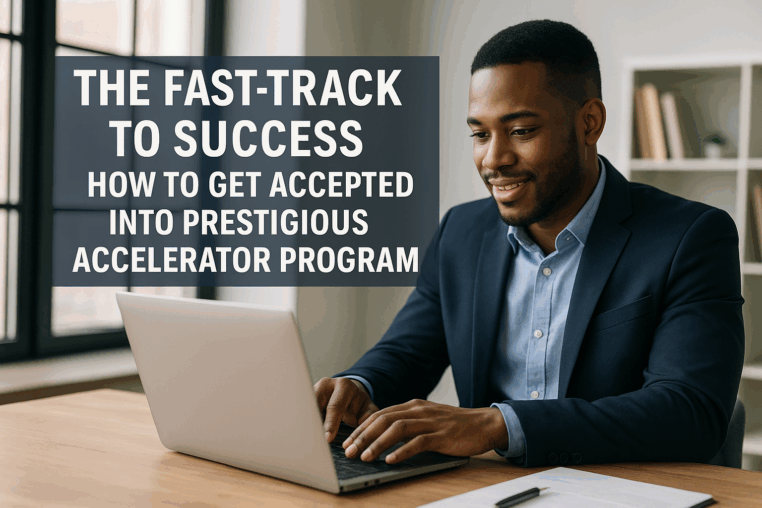The Rocket Fuel Your Startup Needs: Understanding Accelerator Programs
Are you a founder with an early-stage company that’s ready to explode onto the global market? The time-for-money hustle has its limits, and the next level involves scaling your vision rapidly. This is where startup accelerator programs come in.
A startup accelerator is a fixed-term, cohort-based program that includes mentorship, educational programming, and resources, culminating in a “Demo Day” where founders pitch to investors. Getting accepted is like winning a golden ticket—it provides seed funding, invaluable networking, and the stamp of approval that attracts later-stage capital. But securing a spot in a top-tier program (like Y Combinator, Techstars, or a major regional player) is brutally competitive.
Here is the blueprint for creating an application that demands attention.
Part 1: The Non-Negotiable Pre-Application Work: Traction is King
Accelerators don’t fund ideas; they fund proof of concept and execution. The best application you can submit is one that shows you’re already doing the work—and it’s working.
1. Build an MVP (Minimum Viable Product)—Now!
Before you spend weeks perfecting your pitch deck, spend that time building something users can actually use. An MVP can be built quickly and cheaply using free tools like Notion, Google Sheets, or a simple landing page.
Actionable Tip: Don’t wait for perfection. Launch a prototype, gather user feedback, and iterate. Accelerators are impressed by your ability to move fast, not by a flawless design.
2. Focus Ruthlessly on Early Metrics (Traction)
- Traction is evidence of market demand. Showcase your early wins, no matter how small:
- User Engagement: Are people coming back? (Daily/Weekly Active Users).
- Revenue: Even if it’s only a few hundred dollars, early revenue proves someone is willing to pay to solve the problem.
- Growth Rate: Show that your numbers are improving month-over-month. A small base that’s growing 20% MoM is more exciting than a large, stagnant base.
3. Validate Your Market and Problem
Your application must clearly articulate the pain point you solve and the size of the opportunity. Use specific data to back up your claims. Don’t say “Everyone needs this.” Say, “20,000 SMEs in our target region spend an average of N50,000 monthly on this inefficient process.”
Part 2: The Pitch Perfect Application: Selling the Team and the Vision
Your application is a test. It tests your ability to communicate clearly, your understanding of the market, and your potential for rapid growth.
1. Highlight the Unstoppable Team
Accelerators know the initial idea will pivot. They bet on the founders.
- Complementary Skills: Demonstrate that your team has all the crucial bases covered: the Hacker (Tech), the Hipster (Design/Product), and the Hustler (Sales/Business).
- Proof of Execution: Use your application space to share a concise, high-impact success story (like a quick Twitter Thread Showcase. Show, don’t just tell, that you execute flawlessly.
- Coachability: Express genuine excitement about the mentorship aspect of the program. Funders want founders who are humble enough to learn and pivot when necessary.
2. Define the “Why Now?”
Why is your solution necessary right this minute? This shows you understand market timing. Point to a recent technological shift, a new regulatory change, or a sudden cultural trend that creates the perfect window of opportunity for your product. This demonstrates high-level strategic thinking.
3. Master the Video Application
- Many top accelerators require a short, 1-2 minute video. Treat this as a highly condensed Elevator Pitch
- Be Energetic: Show genuine enthusiasm and passion for the problem you are solving.
- Be Clear: State the problem, your solution, and your traction (metrics) in the first 60 seconds.
- Show the Team: Let the reviewers see the personalities and chemistry of the people they will be backing.
Part 3: The Secret Sauce — Fit, Focus, and Follow-Up
1. Research for Program Fit
Don’t spray and pray. Research which specific program (vertical, location, mission) aligns with your startup’s stage and needs.
Customize: Mention specific mentors or alumni from that program whose work directly inspires you. This shows you’ve done your homework.
2. The Clear “Ask”
If you get an interview, know exactly what you need from the accelerator. Don’t say “money and advice.” Say, “We need an introduction to three major distributors in Lagos, and mentorship on scaling our customer acquisition model from X to 10X.” This proves you’ve thought seriously about the next stage.
🎯 Key Takeaways for Your Accelerator Journey
- Focus Area Your Key Deliverable Why it Matters to the Funder
- Product A functional MVP and proof of engagement. Demonstrates you can build and users want it.
- Traction Early metrics (growth rate, users, revenue). Proves market demand and execution ability.
- Team Complementary skills and commitment (full-time). Shows the engine is durable and coachable.
- Pitch A clear, enthusiastic video application. Tests your communication and selling skills. Getting into a prestigious accelerator program is a marathon of preparation and a sprint of execution. Start building your traction today, and you’ll be ready when that application window opens! To deeply understand this check out my previous post on elevator pitch

